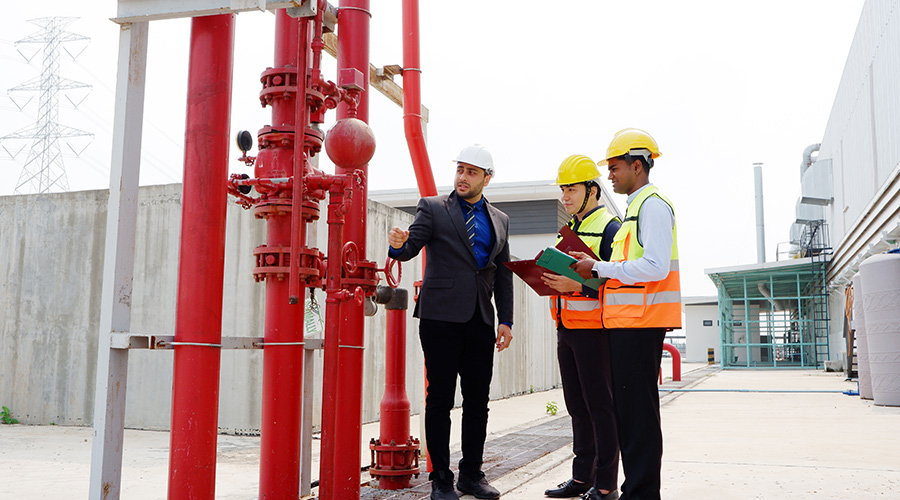Fighting Fire with Training
Developing a successful training program for fire safety starts with understanding the essential issues
Facilities’ fire-safety systems are under increasing scrutiny in recent years in light of several high-profile fires. One essential component of fire safety is training for front-line technicians involved in the specification, installation, testing and maintenance of key system components.
A basic principle of management states that if you delegate, you must educate. So before managers can delegate responsibility for fire-safety tasks, they must provide proper training and education.
Developing Plans and Questions
Some fire-safety considerations apply to every situation, but other considerations are a function of a specific need and, as a result, require steps customized to each facility. The U.S. Occupational Safety and Health Administration (OSHA) describes a fire-safety plan as one that deals with five issues related to preparation and training.
They are: a list of major workplace fire hazards; ignition sources, such as chemistry labs, welding areas and smoking areas; types of fire-protection equipment or systems to control a fire involving each flammable item or ignition source; names and titles of officials responsible for inspection and maintenance of fire-protection systems; and names and titles of those responsible for control of fire-source hazards.
The key questions management needs to answer to develop an optimum fire-safety plan and training program are:
-
Class B — flammable or combustible gases and liquids, such as oil and grease
-
Class C — energized electrical equipment
-
Class D — combustible metals, such as magnesium, titanium, zirconium, sodium, lithium and potassium.
What kinds of fire hazards exist in this facility? Fire-safety professionals have adopted four fire hazard classes based upon the materials that might be ignition sources. They are:
-
Managers must sort all materials in their facilities into these four classes to determine the amount and type of hazards in the facility and their locations.
What fire-extinguishing systems are required to address these hazards? Managers can use the sorted list of hazards to determine the types of fire-extinguishing systems appropriate for each area. Both fixed and portable systems generally are combined to provide the most effective fire-safety system.
-
Fixed systems include automatic dry-pipe or wet-pipe systems that discharge automatically when heat melts the seal in the sprinkler head in the ceiling. They also include hose systems, which are activated manually. For these systems, considerations such as the number and distribution of sprinkler heads are part of the design.
-
Also, meeting the minimum unobstructed distance to the head — OSHA specifies 18 inches — is management’s responsibility. Since shelves and moveable equipment can affect this clearance, it is usually the responsibility of the in-house safety person to check this situation at least monthly.
-
Portable systems can be either a wheeled fire extinguisher or handheld extinguishers that one properly trained person can operate. Monthly visual inspection of portable fire extinguishers is required, along with annual inspection and periodic hydrostatic testing.
-
Inspections help determine if they are stationed at proper intervals, if employees can access them without endangering themselves, and if stations are clear for access.
-
Many OSHA standards describe subjects and content that management can use to determine items to include in their fire-safety-training program. Other standards deal with subjects such as means of egress, number of exits, adequate and reliable exit lighting, flammable materials, and ignition sources.
What is the best evacuation plan for this facility? Emergency-action plans describe procedures to follow to ensure employee safety in the event of a fire or other emergency. Items included in the plan are designation of evacuation coordinators, evacuation routes, assembly areas, special procedures for the disabled, and checking evacuated areas to ensure that all have been evacuated.
Finding Effective Training
Managers have many sources to choose from for effective, approved training. They include OSHA and its area offices, state occupational advisory services, the National Fire Protection Association (NFPA), National Board of Fire Underwriters, and approved commercial fire-safety programs and courses from which managers can develop their own courses.
Course media available include CD-ROMs, videos, films, DVDs, textbooks, pamphlets and workbooks, as well as practical applications using actual fire-safety equipment. Typical courses contain subjects, such as common fire causes, fire-protection and prevention methods, proper methods to minimize dangers using portable fire extinguishers, rapid and safe evacuation procedures, and first aid.
Training courses contain a complete package of instructor and student materials. Typically, a course package contains training booklets for each student, fire-safety posters, instructor training guides, quizzes and certificates.
Material safety data sheets provided by manufacturers in compliance with employee right-to-know laws about materials they handle are useful training components. The sheets list, among other things, the chemical composition, hazards, flammability, storage and handling methods, personal protective equipment, the type of extinguishing agent to use, and first-aid treatment.
Measuring Effectiveness
Quizzes and certificates can help managers measure training effectiveness. Managers can use these aids to test students’ comprehension of the material and as a means of certifying that workers have satisfactorily completed the required fire safety courses. Managers also should keep these quizzes and certifications on file for viewing by fire-safety inspectors to provide evidence of proper training and annual updates to training for covered employees.
Finally, managers should use a tracking system — a database that keeps management informed of the current status of the program, including who has been trained; and the resulting certification; who needs training; who is due for annual retraining; and who has completed annual retraining, when and the outcome.
Training Resources
The National Fire Protection Association (NFPA) offers information useful in fire-safety programs, including more than 300 codes covering basic fire safety, the National Electrical Code, and life-safety subjects.
The NFPA’s fire diamond symbol ranks fire hazards from not hazardous to most hazardous. NFPA's Fire Protection Guide to Hazardous Materials, 13th Edition, includes NFPA code 704, Standard System for the Identification of the Hazards of Materials for Emergency Response, as well as ratings for more than 3,000 chemicals.
For managers who want a combination of outside and in-house programs included in fire safety training, OSHA references several fire-safety training schools in its fire-safety advisories.
These schools include the Maryland Fire and Rescue Institute, Iowa Fire Service extension, Georgia Fire Academy, New York State Department of Fire Prevention and Control, Louisiana State University Firemen Training Program, Washington State Fire Service Training Commission. www.osha.gov
Other resources include:
|
Related Topics:











